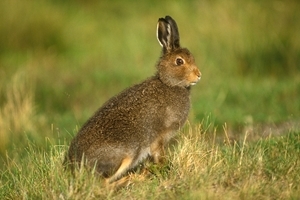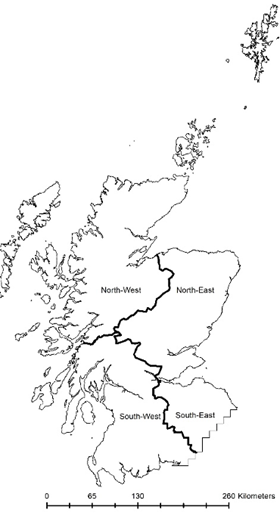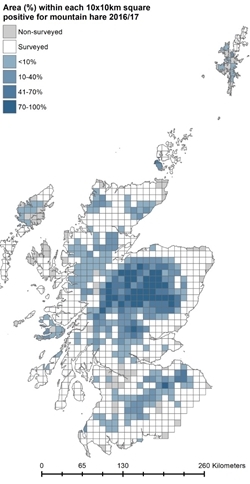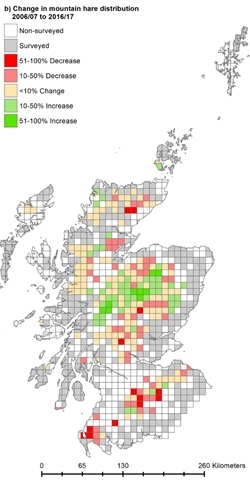Key points
- Mountain hares are hunted for sport and are killed as part of red grouse management and to protect some habitats.
- This study found mountain hares were most widespread in northeast Scotland compared to other regions, whilst the greatest declines in range were in southwest Scotland.
- Management for driven grouse shooting is likely to be beneficial for hare populations, and culling mountain hares was not linked to changes in distribution.
- Changes in land use and a decrease in grouse shooting may play an important role in mountain hare range contractions.
Background
 Almost all the British population of mountain hares are found in the Scottish Highlands and southern uplands, but they have also been reintroduced in the Peak District in England. In Scotland, higher numbers of mountain hares are linked to grouse shooting, where they benefit from the heather management and predator control carried out by gamekeepers.
Almost all the British population of mountain hares are found in the Scottish Highlands and southern uplands, but they have also been reintroduced in the Peak District in England. In Scotland, higher numbers of mountain hares are linked to grouse shooting, where they benefit from the heather management and predator control carried out by gamekeepers.
Mountain hare numbers are managed for many reasons including hunting for sport, culling to protect young forests, and to control viruses carried by ticks. The latter is thought to help protect red grouse but causes concerns about the potential impact on hare populations.
In Scotland, the conservation status of the mountain hare recently changed from ‘Favourable’ to ‘Unfavourable-Inadequate’ after a five-year assessment. It was thought that hunting and game management were contributing to pressure on mountain hare populations; however, the actual conservation status of hares in Scotland is unknown. This is because, until recently, there has been no national monitoring scheme or standardised method to count hares in Scotland. Therefore, there is limited information to draw conclusions about trends and distribution, and the information that does exist is conflicting.
In 1995 and 2006, national questionnaire surveys were used to assess the changes in hare distribution across Scotland. In this study, scientists repeated these questionnaire surveys to examine how mountain hare distribution had changed over a 20-year period. They looked at changes in relation to grouse moor management, and also considered whether changes in the distribution were associated with the number of hares killed.
What they did
Questionnaire-based surveys were originally carried out in 1995/96 and 2006/07, where landowners and managers were asked to provide information on where mountain hares had been seen, and the number killed (the bag) on their estates during the survey period.
These were repeated in 2016/17, using the same methods to make sure the data were comparable. The surveys were sent to Scottish landowners and managers who were members of the Game & Wildlife Conservation Trust, Scottish Gamekeepers Association or Scottish Land and Estates, and those who had responded to the earlier surveys. The first survey included upland moors only, but the repeat in 2006/07 and this study in 2016/17 also covered lowland areas of Scotland. The questionnaires documented mountain hare range based upon sightings, and collected information on the number of hares culled on each estate.
 During the analysis, the responses were split into four regions to examine how distribution changed across Scotland. These were:
During the analysis, the responses were split into four regions to examine how distribution changed across Scotland. These were:
- North-West
- South-West
- North-East
- South-East
To understand how mountain hare distribution was related to grouse shooting, the scientists also categorised questionnaire responses according to the main estate management type. These were:
- Managed for driven grouse shooting
- Managed for walked-up grouse shooting
- No grouse shooting
To understand whether the number of hares killed was related to changes in their range, the kill density was used. This measured the number of mountain hares killed per km2.
The scientists looked at the relationship between grouse moor management and the changes in hare distribution over the 20-year period, examining the regional differences between the four areas of Scotland and whether these changes are associated with the numbers killed.
For this research, current hare range and changes in range were recorded. Range is the area occupied by a species and is an important measurement, as reductions in range are often one of the first indicators of a species under pressure and may be followed by falling numbers.
What they found
Distribution
The questionnaire responses covered more than 90% of Scotland, making this the most extensive distribution survey of mountain hares to date. The scientists found that mountain hares were widespread across northeast Scotland, but less so in other regions. Across all regions, mountain hare range was greatest on estates managed for driven grouse shooting, and these estates accounted for two thirds of the total area where mountain hares were reported in 2016/17.
| Region |
Percentage of the
region with hares |
| North-East |
46% |
| North-West |
23% |
| South-East |
27% |
| South-West |
10% |

This map shows the percentage of each 10km2
area with hares reported to be present in the
2016/17 survey.
This map shows the change in
mountain hare distribution between
2006/07 and 2016/17.The most notable change between surveys was seen in the North-West region, where the area on which mountain hares were recorded (the range) increased by 61% on driven grouse moors, fell by 57% on walked-up grouse moors and did not change in areas with no grouse management. In the South-West, the range decreased by 52% on driven and 68% on walked-up moors but was relatively stable in areas with no grouse shooting interest. However, the study shows that mountain hare range was still three times higher on driven grouse shooting estates than other types of estates in 2016/17.
For the additional estates that joined the survey in 2006/07, the ten-year period to 2016/17 saw a 5% increase in average mountain hare range in the North-East and a 63% decrease in the South-West, but no change in the North-West and South-East regions. These changes were irrespective of land use. This is demonstrated in the distribution map, showing the percentage changes in distribution between 2006/07 and 2016/17.
Culling data
The number of mountain hares culled increased across the 20 years. However, cull density (the number of hares culled per km2), remained similar between 2006/07 and 2016/17. Furthermore, there was no relationship found between hare culls and changes in mountain hare range and the increase in bag records probably reflect natural fluctuations in mountain hare numbers.
What does this mean?
Across all four regions of this study, mountain hare range was greatest on driven grouse shooting estates, compared to walked-up estates or where there was no grouse shooting. This supports previous studies showing the positive association between grouse management and hare populations. When managing for grouse, gamekeepers maintain the land by controlling predators and heather – this could improve both food supply and survival for mountain hares.
The difference between regions may also be attributed to land management. In North-East Scotland, where there is intensive land management for grouse shooting, hares are more widespread. However, in the South-West grouse shooting has declined, leading to a change in land management. These changes in land use, from heather moorland to forestry and sheep grazing, are also thought to have contributed to the loss of some moorland birds (e.g. curlew, golden plover and black grouse). The scientists in this study reported the greatest range contractions in these areas.
Although there has been an increase in the numbers of hares killed over the last 20 years, range contractions seem to be unrelated to this culling and, instead, the loss of moorland habitat and changes in land management might be more important. Future research needs to focus on untangling these ecological factors to better understand the cause of the changes in the range of mountain hares in Scotland.
Read the original paper
Hesford, N., Baines, B., Smith, A. A. and Ewald, A. J. 2020. Distribution of mountain hares Lepus timidus in Scotland in 2016/2017 and changes relative to earlier surveys in 1995/1996 and 2006/2007. Wildlife Biology 2020: DOI (10.2981/wlb.00650)